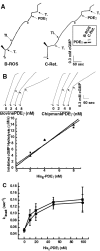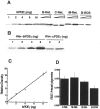GTPase regulators and photoresponses in cones of the eastern chipmunk
- PMID: 12598617
- PMCID: PMC6742256
- DOI: 10.1523/JNEUROSCI.23-04-01287.2003
GTPase regulators and photoresponses in cones of the eastern chipmunk
Abstract
Vertebrate cone and rod photoreceptor cells use similar mechanisms to transduce light signals into electrical signals, but their responses to light differ in sensitivity and kinetics. To assess the role of G-protein GTP hydrolysis kinetics in mammalian cone photoresponses, we have characterized photoresponses and GTPase regulatory components of cones and rods from the cone-dominant retina of the eastern chipmunk. Sensitivity, based on the stimulus strength required for a half-maximum response, of the M-cone population was 38-fold lower than that of the rods. The relatively lower cone sensitivity could be attributed in part to lower amplification in the rising phase and in part to faster recovery kinetics. At a molecular level, cloning of chipmunk cDNA and expression of recombinant proteins provided standards for quantitative immunoblot analysis of proteins involved in GTPase acceleration. The ratio of the cGMP-phosphodiesterase inhibitory subunit gamma to cone pigment, 1:68, was similar to the levels observed for ratios to rhodopsin in bovine retina, 1:76, or mouse retina, 1:65. In contrast, the ratio to pigment of the GTPase-accelerating protein RGS9-1 was 1:62, more than 10 times higher than ratios observed in rod-dominant retinas. Immunoprecipitation experiments revealed that, in contrast to rods, RGS9-1 in chipmunk retina is associated with both the short and long isoforms of its partner subunit G(beta5). The much higher levels of the GTPase-accelerating protein complex in cones, compared with rods, suggest a role for GTPase acceleration in obtaining rapid photoresponse kinetics.
Figures








Similar articles
-
Slowed recovery of rod photoresponse in mice lacking the GTPase accelerating protein RGS9-1.Nature. 2000 Feb 3;403(6769):557-60. doi: 10.1038/35000601. Nature. 2000. PMID: 10676965
-
Tokay gecko photoreceptors achieve rod-like physiology with cone-like proteins.Photochem Photobiol. 2006 Nov-Dec;82(6):1452-60. doi: 10.1562/2006-01-05-RA-767. Photochem Photobiol. 2006. PMID: 16553462
-
The effector enzyme regulates the duration of G protein signaling in vertebrate photoreceptors by increasing the affinity between transducin and RGS protein.J Biol Chem. 2000 Oct 20;275(42):32716-20. doi: 10.1074/jbc.C000413200. J Biol Chem. 2000. PMID: 10973941
-
Molecular mechanisms characterizing cone photoresponses.Photochem Photobiol. 2007 Jan-Feb;83(1):19-26. doi: 10.1562/2006-02-28-IR-823. Photochem Photobiol. 2007. PMID: 16706600 Review.
-
Tuning outer segment Ca2+ homeostasis to phototransduction in rods and cones.Adv Exp Med Biol. 2002;514:179-203. doi: 10.1007/978-1-4615-0121-3_11. Adv Exp Med Biol. 2002. PMID: 12596922 Review.
Cited by
-
Functional comparison of rod and cone Gα(t) on the regulation of light sensitivity.J Biol Chem. 2013 Feb 22;288(8):5257-67. doi: 10.1074/jbc.M112.430058. Epub 2013 Jan 3. J Biol Chem. 2013. PMID: 23288843 Free PMC article.
-
Q344ter mutation causes mislocalization of rhodopsin molecules that are catalytically active: a mouse model of Q344ter-induced retinal degeneration.PLoS One. 2010 Jun 2;5(6):e10904. doi: 10.1371/journal.pone.0010904. PLoS One. 2010. PMID: 20532191 Free PMC article.
-
Quantitative modeling of the molecular steps underlying shut-off of rhodopsin activity in rod phototransduction.Mol Vis. 2016 Jun 17;22:674-96. eCollection 2016. Mol Vis. 2016. PMID: 27375353 Free PMC article.
-
Low activation and fast inactivation of transducin in carp cones.J Biol Chem. 2012 Nov 30;287(49):41186-94. doi: 10.1074/jbc.M112.403717. Epub 2012 Oct 8. J Biol Chem. 2012. PMID: 23045532 Free PMC article.
-
Photoreceptor physiology and evolution: cellular and molecular basis of rod and cone phototransduction.J Physiol. 2022 Nov;600(21):4585-4601. doi: 10.1113/JP282058. Epub 2022 Apr 28. J Physiol. 2022. PMID: 35412676 Free PMC article. Review.
References
-
- Angleson JK, Wensel TG. Enhancement of rod outer segment GTPase accelerating protein activity by the inhibitory subunit of cGMP phosphodiesterase. J Biol Chem. 1994;269:16290–16296. - PubMed
-
- Arshavsky VY, Lamb TD, Pugh EN., Jr G proteins and phototransduction. Annu Rev Physiol. 2002;64:153–187. - PubMed
-
- Babu KR, Dukkipati A, Birge RR, Knox BE. Regulation of phototransduction in short-wavelength cone visual pigments via the retinylidene Schiff base counterion. Biochemistry. 2001;40:13760–13766. - PubMed
Publication types
MeSH terms
Substances
Grants and funding
LinkOut - more resources
Full Text Sources
